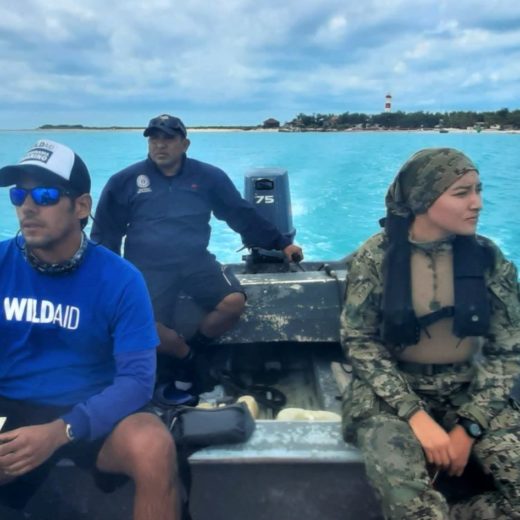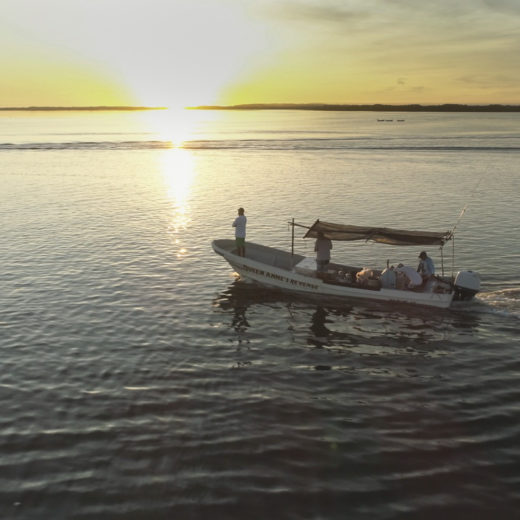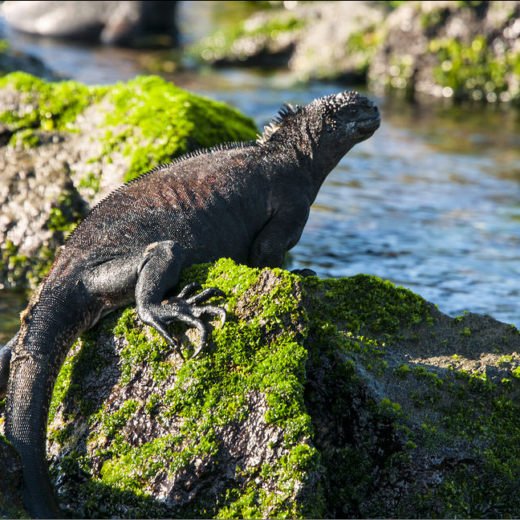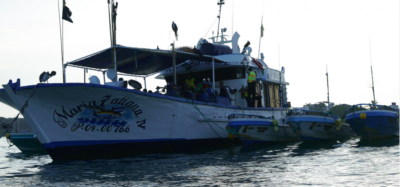
BY SILVIA SANCHEZ, WILDAID MARINE PROGRAM
Late last week, a commercial fishing vessel and its six fiberglass boats were caught illegally fishing within the Galapagos Marine Reserve with a catch of 160 sharks and other fish.
The Maria Tatiana IV, a fishing vessel from continental Ecuador entered the Galapagos Marine Reserve’s boundaries late Thursday night. Park rangers in the Galapagos National Park control center monitored its trajectory using electronic surveillance while patrol vessels sped towards the fishing vessel, having been alerted to this suspicious activity.
After a full day and night chasing the poachers at sea, the Galapagos park rangers and Ecuadorian Navy arrested 21 crew members and seized all seven boats, the long lines and the bounty of illegally caught species. These included 81 sharks—36 silky sharks, 24 blue sharks, 14 pelagic thresher sharks, six bigeye thresher sharks and one great white shark.
21 Shark Finners Arrested in the Galapagos Marine Reserve from WildAid on Vimeo.
An estimated 73 million sharks are killed each year for the illegal shark fin trade around the world. To stop shark finning in the Galapagos, WildAid works with the Navy and park rangers to monitor the vast reserve and prevent illegal fishing. Last year, we updated the electronic surveillance system in the park’s control center to continue tracking all large fishing and tourism vessels. Since its installation in 2009, this technology has helped park rangers capture and sentence more than 100 industrial and artisanal fishing vessels, such as the Fer Mary I that was caught with 350 illegally caught sharks in its hold. This is the first illegal fishing arrest since the system update and since the announcement of a new marine sanctuary at Darwin and Wolf to protect sharks.
Although this technology has been a great tool for Galapagos park rangers and Navy officials, monitoring smaller vessels is especially challenging, which threatens mantas, sharks, sea turtles, and dolphins that get caught on fishing lines as bycatch or are illegally targeted for the lucrative wildlife trade.
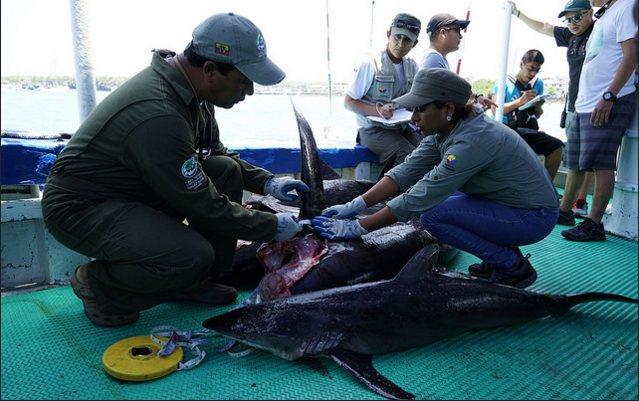

Earlier this year, Ecuador announced that all its vessels, no matter their size, will now be monitored in real time. The new legislation means that an additional 11,000 small vessels throughout the marine environment will now be tracked, which will further deter illegal fishing activity in the Galapagos Marine Reserve and along coastal Ecuador.We are working with the Ecuadorian Undersecretary of Marine and Coastal Resources and Ecuadorian Navy to implement this tracking at two pilot sites along coastal Ecuador: Machalilla National Park and Santa Clara Island.
WildAid has used its comprehensive marine protection model to decrease illegal fishing and protect nearly 3,000 marine species in the Galapagos Marine Reserve since 2002 thanks to the support of the Helmsley Charitable Trust, Conservation International, Mission Blue, IGTOA, the Walton Family Foundation and WWF.
Español
21 Pescadores Fueron Detenidos por Pesca Ilegal en la Reserva Marina Galápagos
La semana pasada una embarcación de pesca industrial y seis embarcaciones pequeñas (fibras) fueron detenidas porque realizaban faenas de pesca 10 millas dentro de la Reserva Marina Galápagos, las bodegas del barco contenían aproximadamente 81 tiburones de cinco especies y otras especies de peces.
La embarcación Maria Tatiana IV, del Ecuador continental entró a la reserva marina el día Jueves en la noche. Los guardaparques de la Dirección Nacional del Parque Galápagos (DPNG) durante sus patrullaje de rutina detectó y capturó a la embarcación en la madrugada del día viernes 08 de abril.
Los guardaparques de la DPNG y la Armada de Ecuador detuvieron a los 21 tripulantes y entre las evidencias se encuentran retenidas las siete embarcaciones, sus palangres (arte de pesca no permitido en la RMG), y las especies capturadas; estas incluyeron 81 tiburones—36 tiburones silkys (Carcharhinus falciformis), 24 azul (Prionace glauca), 14 zorro pelágico (Alopias pelagicus), 6 zorro ojón (Alopias superciliosus), y un tiburón blanco (Carcharodon carcharias).
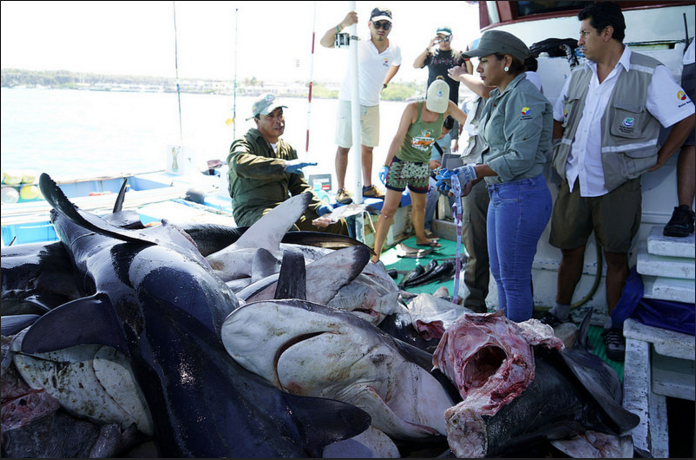

Aproximadamente 73 millones de tiburones son capturados cada año por sus aletas a través del mundo. Para eliminar esta práctica en las islas Galápagos, WildAid apoya a la Dirección del Parque Nacional Galápagos, la Armada y sus guardaparques en la vigilancia de la reserva para prevenir actividades ilícitas como la pesca ilegal. El año pasado, se logró repotenciar el sistema de monitoreo en el centro de control de la DPNG, ubicado en la isla Santa Cruz y de esta forma monitorear todas las embarcaciones de pesca y turismo. Desde su instalación en 2009, la tecnología ayudó a los guardaparques a capturar y penalizar a más de 100 embarcaciones industriales y artesanales, como la Fer Mary I que se encontró con 350 tiburones en su bodega. Esta captura es la primera desde la repotenciación del sistema y desde el anuncio del nuevo santuario marino Darwin y Wolf.
Aunque esta tecnología ha sido una gran ayuda para los guardaparques de Galápagos, el monitoreo de las embarcaciones pequeñas es especialmente difícil, poniendo en peligro a mantarrayas, tiburones, tortugas marinas y otras especies, que pueden quedarse atrapadas en las líneas de pesca como pesca incidental o que son capturadas por el comercio ilícito.


El diciembre del 2015, el gobierno de Ecuador promulgó una regulación donde se exige a todas las embarcaciones el uso de dispositivos de monitoreo, para su localización y seguimiento en los espacios marinos a nivel nacional. Con esta nueva regulación aproximadamente 11000 embarcaciones podrán ser monitoreadas para detectar y disuadir actividades ilícitas en la Reserva Marina Galápagos y a través de la costa del continente ecuatoriano. WildAid está trabajando con la Subsecretaría de Recursos Marino Costeros de Ecuador y la Armada en un proyecto piloto para implementar este nuevo sistema en dos sitios de la costa: Parque Nacional Machalilla e Isla Santa Clara.
Junto con la DPNG, WildAid utiliza su modelo comprensivo de protección marítima para disminuir la pesca ilegal en la Reserva Marina Galápagos y proteger a sus 3,000 especies marinas desde el 2002 gracias al apoyo de Helmsley Charitable Trust, Conservación Internacional, Mission Blue, IGTOA, Walton Family Foundation y WWF.
Donen hoy al programa marino de WildAid para apoyar a nuestro trabajo contra la pesca ilegal en Galápagos y en proteger a las especies marítimas en peligro como tiburones y mantarrayas.
Fotos y video gracias al Parque Nacional Galápagos y la Dirección del Parque Nacional Galápagos
Stay in touch and get the latest WildAid updates.
SIGN UP
